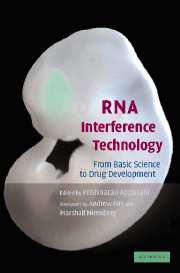Book contents
- Frontmatter
- Contents
- Foreword by Andrew Fire
- Foreword by Marshall Nirenberg
- List of Contributors
- Introduction
- Section one Basic RNAi, siRNA, microRNAs and gene-silencing mechanisms
- Section two Design, synthesis of siRNAs
- Section three Vector development and in vivo, in vitro and in ovo delivery methods
- 10 Six methods of inducing RNAi in mammalian cells
- 11 Viral delivery of shRNA
- 12 siRNA delivery by lentiviral vectors: Design and applications
- 13 Liposomal delivery of siRNAs in mice
- 14 Chemical modifications to achieve increased stability and sensitive detection of siRNA
- 15 RNA interference in postimplantation mouse embryos
- 16 In ovo RNAi opens new possibilities for functional genomics in vertebrates
- Section four Gene silencing in model organisms
- Section five Drug target validation
- Section six Therapeutic and drug development
- Section seven High-throughput genome-wide RNAi analysis
- Index
- Plate section
- References
12 - siRNA delivery by lentiviral vectors: Design and applications
Published online by Cambridge University Press: 31 July 2009
- Frontmatter
- Contents
- Foreword by Andrew Fire
- Foreword by Marshall Nirenberg
- List of Contributors
- Introduction
- Section one Basic RNAi, siRNA, microRNAs and gene-silencing mechanisms
- Section two Design, synthesis of siRNAs
- Section three Vector development and in vivo, in vitro and in ovo delivery methods
- 10 Six methods of inducing RNAi in mammalian cells
- 11 Viral delivery of shRNA
- 12 siRNA delivery by lentiviral vectors: Design and applications
- 13 Liposomal delivery of siRNAs in mice
- 14 Chemical modifications to achieve increased stability and sensitive detection of siRNA
- 15 RNA interference in postimplantation mouse embryos
- 16 In ovo RNAi opens new possibilities for functional genomics in vertebrates
- Section four Gene silencing in model organisms
- Section five Drug target validation
- Section six Therapeutic and drug development
- Section seven High-throughput genome-wide RNAi analysis
- Index
- Plate section
- References
Summary
Introduction
A major challenge in the post genomic era of biology is to decipher the molecular function of over 30,000 genes. The gene knock-out by homologous recombination has proven to be very useful but is laborious and expensive. RNA interference has recently emerged as a novel pathway that allows modulation of gene expression. The basic biology of RNAi is described in the next section. Briefly, long dsRNA molecules are processed by the endonuclease Dicer into short 21–23 nucleotide small interfering RNAs (siRNAs), which are then incorporated into RISC (RNA-induced silencing complex), a multi-component nuclease complex that selects and degrades mRNAs that are homolgous to the dsRNA initially delivered (Fjose et al., 2001; Hannon, 2002). In mammalian systems, synthetic siRNA's can be delivered exogenously (Elbashir et al., 2001) or can be expressed endogenously from RNA Pol III promoters, resulting in a powerful tool for achieving specific downregulation of target mRNA's (Miyagashi and Taira, 2002; Paul et al., 2002; Oliviera and Goodell, 2003). The delivery of synthetic siRNAs to cells in culture is hampered by limitations in transfection efficiency for many cell types and the transient nature of the silencing effect. In vivo, delivering siRNAs to target cells is difficult due to lack of stability of siRNA and low uptake efficiency in the absence of transfection agents (Isacson et al., 2003). Thus in order to apply this potent technique to both basic biological questions and therapeutic strategies, efficient siRNA delivery methods must be developed.
Information
- Type
- Chapter
- Information
- RNA Interference TechnologyFrom Basic Science to Drug Development, pp. 174 - 185Publisher: Cambridge University PressPrint publication year: 2005
